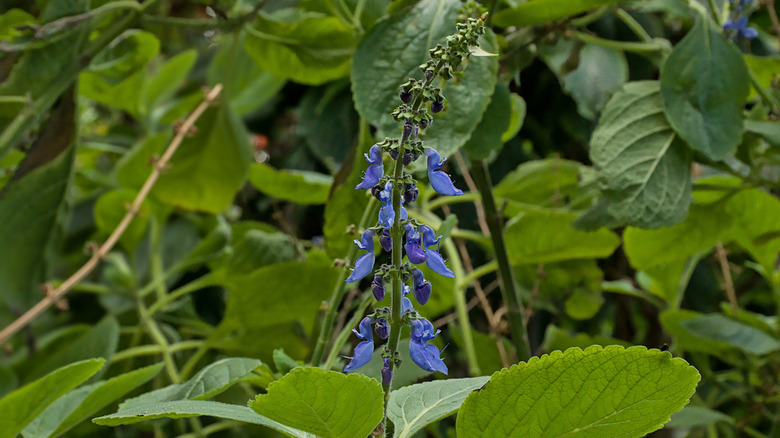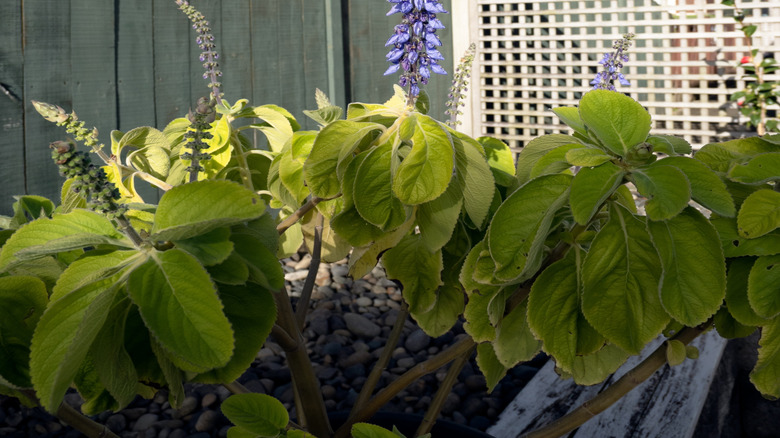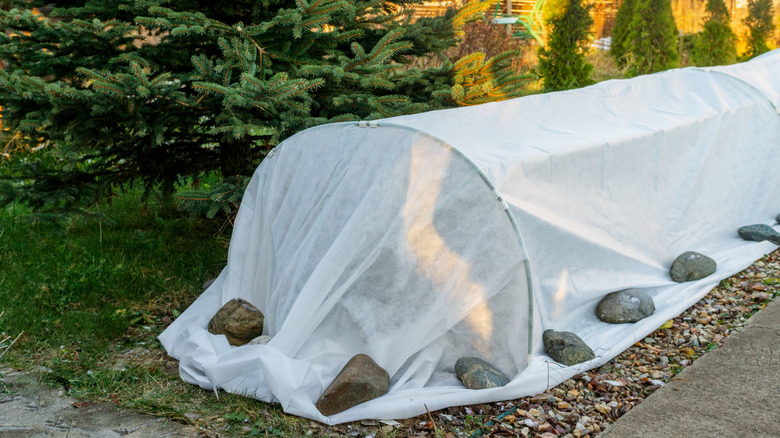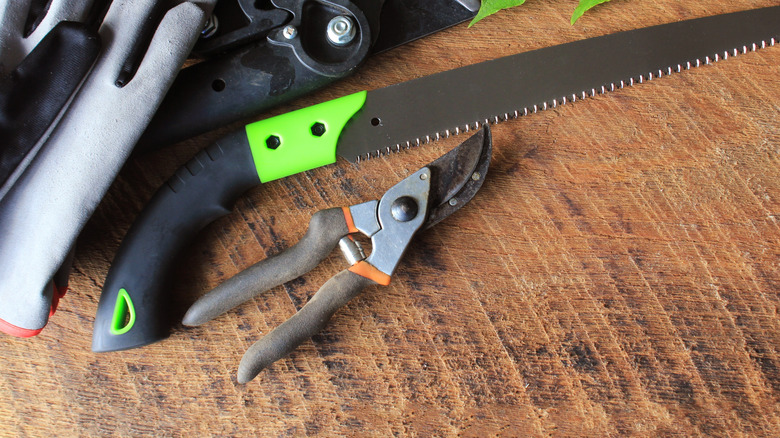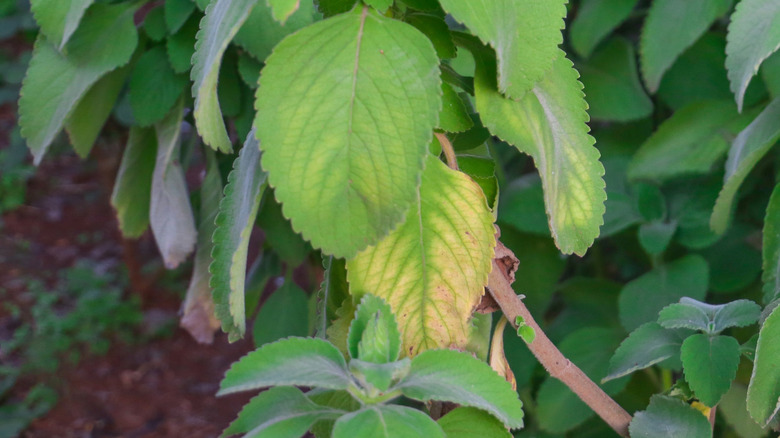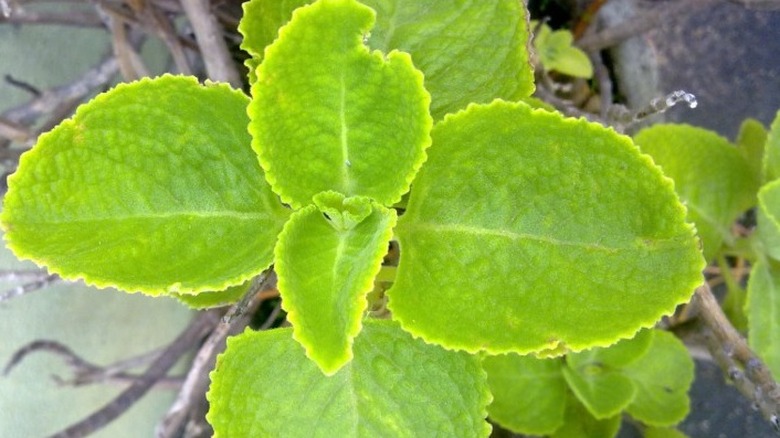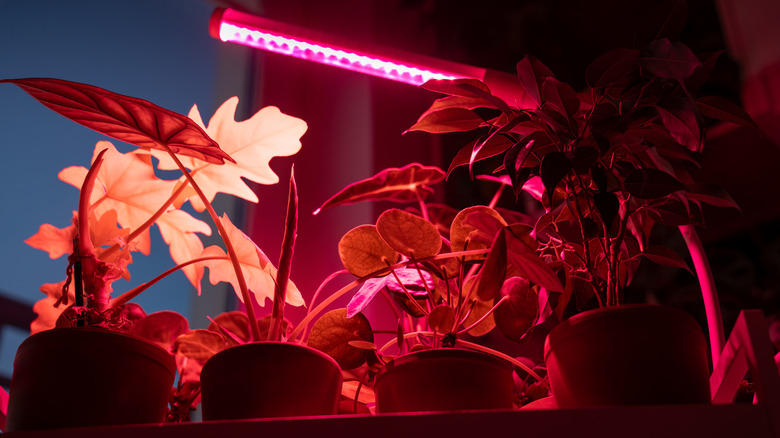Key Tips For Getting Vibrant Blooms From Blue Spur Flowering Plants
We may receive a commission on purchases made from links.
Blue spur flowers are beloved for their gorgeous blooms that pop up at different times throughout the year. Whether you're using these ornamental flowers as groundcover or garden plants, the ultimate goal is to encourage the colorful blooms to emerge. Raising a healthy plant in a good environment is part of the process. However, there are specific caretaking tips to know to ensure the petals are vibrant and plentiful.
Below are seven tips for getting blue spur flowers to blossom. Many different factors come into play, from watering to available sunlight, to ensuring their environmental conditions are kept just right. They are similar to many ornamental plants in that they need well-draining, rich soil to thrive. Blue spur flowers also need sunlight, but not necessarily the same full-sun requirements as some other flowering annuals and perennials. So, learn about what factors encourage blooming blue spurs, as well as how to implement them in your home garden.
Ensure your blue spur flower plant is getting enough sunlight
Blue spur flowers do best with a mix of sunlight and shade. Direct sunlight is fine until the middle of the day, when they should receive partial or filtered sunlight instead. This encourages healthy growth and increases your chance of an impressive flower display. On the other hand, excessive harsh light won't help your blue spur blooms, as it can scorch the leaves.
Blue spurs are not a good flower species if you have no shade in your yard, but they can thrive if you provide the recommended filtered light or partial shade in the middle of the day. Make sure you are thoughtful about where you plant your blue spurs. Ideally, they prefer at least six hours of indirect sunlight a day. You can also prune nearby trees and bushes strategically to ensure that your blue spurs are shielded from the blazing midday sun. Although providing shade is important, also be careful not to completely inhibit their daily sun intake. Avoid planting these flowers up against buildings or large trees that create a large, solid canopy.
Protect your blue spur flower from frost
Blue spurs grow best in USDA zones 9 through 11. These places are known for their milder winters, which reduce the risk of frost. Frost is a huge threat to blue spur flowers, which do best in temperatures from 32 to over 100 degrees. Extreme cold can be a problem, and below freezing temps cause leaves to change color and fall off. You'll likely notice that temperatures have gotten too cold, as blue spur flowers die from the top down.
If you're growing blue spurs in a colder location, or if temperatures drop beyond the norm in the aforementioned zones, frost protection can save flower blooms. Young, potted blue spurs can be brought indoors, but earthbound plants need other forms of protection. Drape a Planket Plant Frost Protection Cover Kit over blue spurs to keep them safe from frigid winds and low temperatures. If you're looking for a more budget-friendly route, use bed sheets in your garden as the weather changes. Just don't forget to remove the setup when the sun comes out and the temperature rises, so they can get their necessary light for the day.
Prune spent flowers to preserve energy for new ones
There are a lot of flowering plants you should always deadhead for maximum blooms. This is also true for blue spur flowers. Chopping away older flowers clears out fading flowers and makes room for new, younger growth. Essentially, this tidies up the plant's appearance and conserves its energy for more flowers. Blue spurs should also be pruned to remove damaged or diseased branches before flowering begins.
Prune blue spurs in late winter and early spring, or during periods in between blooms. Cut them just above a leaf node when doing routine pruning. When deadheading and clipping away older growth, observe the plant before you start snipping. Look for dead flowers, and snip down to where the leaves start looking healthy and vibrant again. Using proper tools while pruning and deadheading makes all the difference. Keep in mind, cleaned and disinfected gardening tools reduce the risk of infection. They should also be sharp enough to make precise cuts that optimize the shape and growth of blue spurs. Various tools, such as bypass pruners, shears, saws, and garden scissors, are useful for flowering shrubs. When trimming branches, Fiskars' Bypass Pruning Shears are strong enough for most shrubs. However, when deadheading, something smaller like Vivosun's Gardening Scissors can make small and precise cuts.
Check the flowers, leaves, stems, and roots for pests and potential diseases
Pests and diseases are harmful to the overall health of blue spurs, just as they are to all flowering plants. This diminishes flowering plants' ability to blossom and causes unsightly physical damage. Some examples of widespread blue spur issues to watch for include mealybugs and leaf or root rot.
You'll recognize a mealybug infestation if your plant leaves feel sticky, and you may notice a white, cotton-like residue. At any sign of these issues, use diluted pest soap, such as Garden Safe Insecticidal Soap, to wash away and deter insects. You can also remove them by spraying blue spurs with water or cutting away infected foliage.
Leaf and root rot are often caused by excessive watering and a high percentage of moisture in the soil. Fortunately, blue spur flowers are drought-tolerant and prefer well-draining garden soil. This makes it much easier to avoid overwatering them, which is often the accidental cause behind these detrimental diseases.
Don't let your blue spur flower dry out for too long
You won't enjoy big flower blooms if blue spurs aren't getting the water they need. Established blue spurs are tolerant to dry conditions, but not immune. When they don't have enough water, plants also can't carry out transpiration and naturally cool themselves. The combination of excessive heat and insufficient water can also cause scorching. Whether the flowers can't blossom or are destroyed by heat, you can't expect vibrant blooms.
Young, newly planted blue spurs have different requirements than an established plant. It's important that new plants have consistently saturated soil for the first few weeks. Then, they should be watered a few times a week for a few months. Once this period passes, your plant should be established enough for more infrequent waterings. New and healthy leaf growth is a good sign that watering once per week or less is enough.
Remember to provide plenty of light for indoor blue spurs
Blue spurs aren't common indoor plants, but smaller ones in pots may need to be brought inside when winter temperatures get too cold. When indoors, you still must provide proper lighting. Changing their sun exposure could cause a slight change in their health and appearance, but blue spurs can adapt their leaves to better absorb light in their new location. Too much shade can reduce flowering and cause legginess. Their foliage also might falter, but they can bounce back. As long as they're getting their recommended six to eight hours of bright indirect light, whether it's from a window or artificial lighting, spur flowers have the potential to thrive.
If there isn't good lighting from a nearby window, ensure blue spurs get sufficient lighting by investing in special plant grow lights or incandescent bulbs. Replace the bulb in a nearby pre-existing light fixture with a Sylvania Incandescent Spot-Gro Grow Light Bulb. Or, if you need a full light setup, the Juhefa Grow Light for Indoor Plants is a standalone special fixture that features LED bulbs instead of incandescents.
